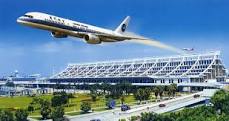Technical or mechanical failure
The airline – although not the investigators – has ruled out technical failure or human error and said the plane was in excellent condition. The crew did not send a distress call.
The Airbus A321 was 18 years old, which is not regarded as a particularly old for an aircraft. It was damaged in an incident in 2001, suffering a tail strike on the runway at Cairo airport, according to the Aviation Safety Network.
Tony Cable, a former senior investigator at the UK Air Accidents Investigation Branch, said that the plane’s history would “certainly be of interest” when looking into causes of a crash. “Tailstrike damage tends to be around the region of the rear pressure bulkhead. The cabin might be pressurised at around six pounds per square inch above outside pressure. But the fuselage directly behind that is at outside pressure. So any weakness or fatigue would be bad news.”
At least one major air disaster has been ascribed to an incorrect repair after a tailstrike. The rear pressure bulkhead of the Boeing 747 used for Japan Airlines flight 123 had been repaired seven years earlier, but not to the exact specification, something that the manufacturer said would reduce its longevity and resistance to fatigue. An explosive decompression led to 520 people dying.
According to an interview with his widow, the pilot of the Metrojet flight had made disparaging comments about the state of the plane before Saturday’s disaster. However, the A321 family of planes has had a strong safety record, despite two recent disasters. A Germanwings A320 was deliberately crashed by the pilot, while the investigation into the Indonesia AirAsia disaster last December is yet to be concluded, but has pointed to a stall after it was flown into an extremely sharp ascent by the pilots.
A missile
Deemed unlikely, but a number of Middle Eastern and European carriers have said they would avoid flying over the Sinai peninsula while the risks were assessed. An Islamic militant group said it was responsible for the downing of the plane, but Moscow has dismissed the claim.
The Metrojet plane reached an altitude of 31,000 feet and experts have been sceptical that militants in Sinai would have the capability to shoot down a craft from that height using a shoulder-launched surface-to-air missile.
Although Malaysian Airlines flight MH17 was flying at 33,000 feet when it was shot down over eastern Ukraine in July 2014, the Buk weapon system that was used needed vehicles to transport it. The range of the MANPADS, or man-portable air-defence systems, believed to be in the hands of Islamic State, and potentially its affiliates, makes lower-flying aircraft a target. But the actions of airlines in avoiding Sinai suggests many have not completely discounted the possibility.
An explosion
If technical failure is eventually ruled out by investigators, a bomb would become the most likely theory, particularly given the recent threatened reprisals againstRussia from Islamic groups. A senior Russian aviation official has confirmed that the plane broke up in mid-air. An explosion on board may have been within the capabilities of groups which threatened reprisals after the Russian bombing of Syria earlier in October.
Aviation security specialists say Sharm el-Sheikh has measures as tight as most airports, but do not discount the possibility of a bomb. A slew of unverified reports from Egypt have left the picture confused, but according to one official quoted by Reuters, the tail section appeared to have separated from the main body of the plane and was burning, which could indicate an explosion.
Details of images from the wreckage in Sinai appear to show the skin of the fuselage peeling outwards, which some sources suggest also points to an onboard explosion.



Be the first to comment